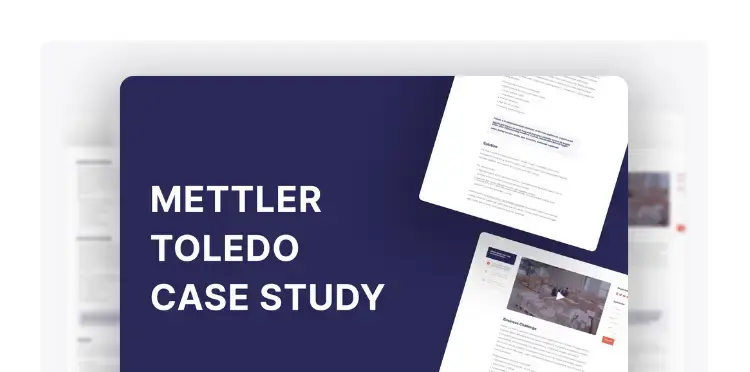Wieland Simplifies Planning and Cuts Inventory 12% with Intuiflow
See how Wieland improved on-time performance by 13% and reduced inventory by 12% with Intuiflow’s demand-driven planning.
See how Mettler Toledo improved service, cut missing parts, and reduced inventory with Intuiflow’s demand-driven planning across 20 plants.

Mettler Toledo, a Swiss–American leader in precision instruments, manufactures everything from laboratory balances and pH meters to industrial scales and food inspection systems.
With operations spanning three global hubs—Shanghai, the Netherlands, and Ohio—and a product portfolio of over one million SKUs, the company’s supply chain is both vast and complex.
By 2018, performance had plateaued. On-time delivery had gone flat, inventory turnover was declining, and forecast accuracy was dropping despite multiple improvement initiatives. Like many fast-growing manufacturers, Mettler Toledo faced the classic symptoms of complexity: too many products, too many forecasts, and too much uncertainty.
“We realized our on-time delivery was flat, our stocks were going up, our inventory turnover was going down, and our forecasts were less and less accurate,” recalls Valéry Carrasco, head of the Demand Driven transformation at Mettler Toledo.
Mettler Toledo’s SAP-driven planning environment was forecast-heavy and slow to adapt. Every deviation from forecast created noise—overproduction in some areas, shortages in others. Planners spent hours managing exceptions that never stabilized.
When management compared alternatives, they saw two paths forward:
At first, the team wasn’t sure. “In 2019, when we began this journey, the honest answer was: we didn’t know if DDMRP was the right solution,” Valéry explains. “But it was easy to try.”
The company launched two pilots to test the methodology.
The first pilot focused on UVB refractometers, precision instruments used in DNA and RNA analysis. Over six months, the team managed roughly 900 materials using a homebuilt system in SAP’s Business Warehouse for HANA.
The results were immediate:
The improvements made believers out of skeptics—and convinced leadership to proceed with a global rollout.
Then COVID-19 struck. Rather than pause the initiative, the team used the disruption to test DDMRP’s resilience.
A second pilot launched across three regions simultaneously, using Intuiflow (previously Replenishment+) as the planning platform. The software connected directly to SAP through automated file exchanges and delivered real-time visibility into component availability and flow.
Even amid supply constraints and shipping delays, the team again saw success:
By 2021, Mettler Toledo had its proof. “After the second pilot, the answer was clear,” Valéry says. “DDMRP is a good solution for us.”
The next challenge was scale. With 20 plants and tens of thousands of materials, traditional sequential deployment would have taken years. Instead, the team implemented DDMRP concurrently in Europe, the U.S., and China, completing the rollout in just two years.
Mettler Toledo used John Kotter’s 8-Step Change Model to manage transformation across regions:
“We had a very small central team—just six people globally—but we empowered every plant to make DDMRP their project,” Valéry explains.
Planners quickly embraced the new model. DDMRP, supported by Intuiflow, made buffers and priorities instantly visible through intuitive Power BI dashboards embedded in the system.
“It’s easy to understand, transparent, and visual,” says Valéry. “The visibility is one of its biggest advantages. You can see immediately where you have the right stock, too little, or too much.”
Across Mettler Toledo’s production organizations:
The company also introduced two major process innovations:
Demand-Driven Execution Priorities:
Production scheduling now follows DDMRP’s execution signals rather than due dates. Operators on the shop floor simply follow color-coded priorities—red for urgent, yellow for watch, green for stable—allowing them to make decisions in real time without schedulers.
In the first three months after implementing this system, no stockouts occurred, and it took eight months before the first minor shortage appeared.
Autopilot: AI-Driven Buffer Optimization:
Collaborating with Demand Driven Technologies, Mettler Toledo tested Autopilot, an AI/ML module within Intuiflow that recommends optimal buffer levels based on historical consumption and desired service levels.
“It’s the first AI tool that tells you which buffer is best for your materials,” Valéry explains. “You set the desired service level, and the system does the rest.”
After full implementation, five of six key business objectives were achieved:
Freight costs were the only KPI not improved—due to global shipping disruptions outside the company’s control.
Most importantly, planners now work by exception, focusing only on what’s critical.
“After two months using DDMRP in Intuiflow, most planners never want to go back to MRP,” Valéry says. “They understand better why we’re ordering materials and see results faster.”
With planning stabilized, Mettler Toledo is now expanding the demand-driven model to tactical and strategic levels through the Demand Driven Adaptive Enterprise (DDAE) framework.
The next steps include:
Mettler Toledo’s transformation demonstrates how Intuiflow helps complex, global manufacturers simplify planning, cut inventory, and sustain growth through real-time visibility and adaptive control.
Intuiflow connects materials planning, scheduling, and execution in one unified platform. Planners manage by priorities, not firefighting, with AI-optimized buffers and live dashboards showing exactly where attention is needed.
Materials Planning: Keep inventory aligned to real demand, avoiding shortages and overstocks.
Scheduling & Execution: Sequence work by true priorities, not arbitrary due dates.
Sales & Operations Planning: Link strategic goals to daily realities through shared visibility.
Demand Planning: Adapt plans dynamically as conditions shift.
With Autopilot, Intuiflow’s AI engine continuously tunes buffers to maintain service while minimizing inventory. Embedded Power BI analytics make performance transparent, and seamless SAP integration ensures data accuracy and fast deployment.
See how Intuiflow can help your organization move from forecast-driven complexity to demand-driven flow.
See how Wieland improved on-time performance by 13% and reduced inventory by 12% with Intuiflow’s demand-driven planning.
See how Miansai cut planning time and achieved 70% online sales growth with Intuiflow in this case study.
Straumann Group scales demand-driven planning globally with Intuiflow, improving service levels, reducing inventory, and achieving double-digit...